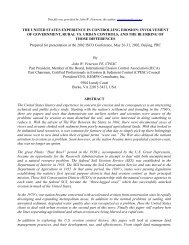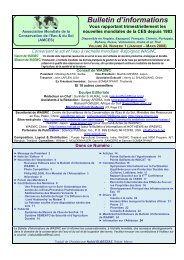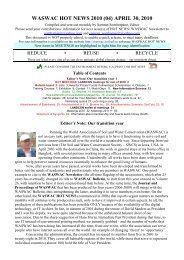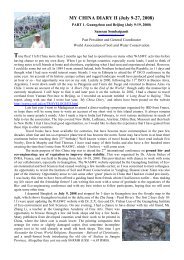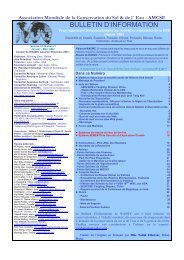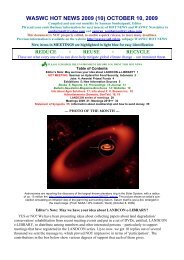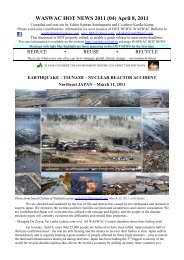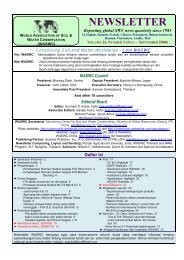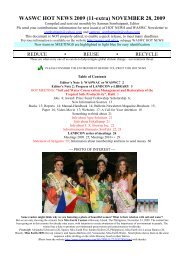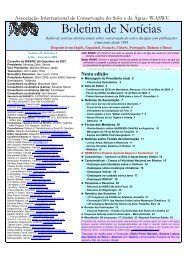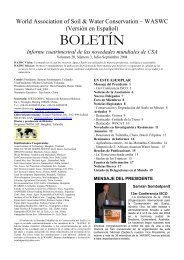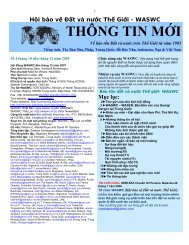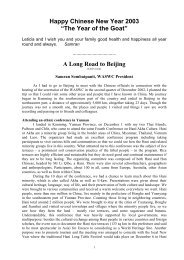clear. The morphology <strong>of</strong> <strong>the</strong> boundaries is variable and sometimes associated with albeluvic tonguing. Albic horizonsusually have coarser textures than <strong>the</strong> overlying or underlying horizons, although this difference with respect to anunderlying spodic horizon may only be slight. Many albic horizons are associated with wetness and contain evidence <strong>of</strong>gleyic or stagnic properties.Diagnostic criteria.An albic horizon must have:1. Munsell colour, dry:a. value <strong>of</strong> ei<strong>the</strong>r 7 or 8 and a chrome <strong>of</strong> 3 or less; orb. value <strong>of</strong> 5 or 6 and a chrome <strong>of</strong> 2 or less; and2. Munsell colour, moist:a. a value 6, 7 or 8 with a chrome <strong>of</strong> 4 or less; orb. a value <strong>of</strong> 5 and a chrome <strong>of</strong> 3 or less 1 ; orc. a value <strong>of</strong> 4 and a chrome <strong>of</strong> 2 or less. A chrome <strong>of</strong> 3 is permitted if <strong>the</strong> parent materials have a hue <strong>of</strong> 5YRor redder, and <strong>the</strong> chrome is due to <strong>the</strong> colour <strong>of</strong> uncoated silt or sand grains; and3. thickness: at least 1 cm.Field identification. Identification <strong>of</strong> albic horizons in <strong>the</strong> field is based on Munsell soil colours. In addition to <strong>the</strong> colourdetermination, checks can be made using a x10 hand-lens to verify if coatings on sand and silt-sized particles are absent.Additional characteristics. The presence <strong>of</strong> coatings around sand and silt grains can be determined using an opticalmicroscope for analysing thin sections. Uncoated grains usually show a very thin rim at <strong>the</strong>ir surface. Coatings may be <strong>of</strong>an organic nature, consist <strong>of</strong> iron oxides, or both, and are dark coloured under translucent light. Iron coatings becomereddish in colour under reflected light, while organic coatings remain brownish-black.Relationships with some o<strong>the</strong>r diagnostic horizons. Albic horizons are normally overlain by humus-enriched surfacehorizons (mollic, umbric or ochric horizons) but may be at <strong>the</strong> surface due to erosion or artificial removal <strong>of</strong> <strong>the</strong> surfacelayer. They can be considered as an extreme type <strong>of</strong> eluvial horizon, and usually occur in association with illuvial horizonssuch as an argic, natric or spodic horizon, which <strong>the</strong>y overlie. In sandy materials albic horizons can reach considerablethickness, up to several metres, especially in humid tropical regions, and associated diagnostic horizons may be hard toestablish.Andic horizonGeneral description. The andic horizon (from Japanese An, dark, and Do, soil) is a horizon resulting from moderatewea<strong>the</strong>ring <strong>of</strong> mainly pyroclastic deposits. However, <strong>the</strong>y may also be found in association with non-volcanic materials(e.g. loess, argilites and ferralitic wea<strong>the</strong>ring products). Their mineralogy is dominated by short-range-order minerals, and<strong>the</strong>y are part <strong>of</strong> <strong>the</strong> wea<strong>the</strong>ring sequence in pyroclastic deposits (tephric soil material (r) vitric horizon (r) andic horizon).Andic horizons may be found both at <strong>the</strong> surface and in <strong>the</strong> subsurface. They also <strong>of</strong>ten occur as layers, separated by nonandiclayers. As a surface horizon, andic horizons generally contain a high amount <strong>of</strong> organic matter (more than 5 percent),are very dark coloured (Munsell value and chrome, moist, is 3 or less), have a fluffy macrostructure and <strong>of</strong>ten a smearyconsistence. They are light in weight (have a low bulk density), and have mostly silt loam or finer textures. Andic surfacehorizons rich in organic matter may be very deep, reaching <strong>of</strong>ten a thickness <strong>of</strong> 50 cm or more (pachic characteristic).Andic subsurface horizons are generally somewhat lighter coloured. Andic horizons may have different properties,depending on <strong>the</strong> type <strong>of</strong> dominant wea<strong>the</strong>ring process acting upon <strong>the</strong> soil material. They may exhibit thixotropy, i.e. <strong>the</strong>soil material changes, under pressure or by rubbing, from a plastic solid into a liquified stage and back into <strong>the</strong> solidcondition. In perhumid climates, humus-rich andic horizons may contain more than 100 percent water (by volume)compared to <strong>the</strong>ir oven-dry volume (hydric characteristic). Two major types <strong>of</strong> andic horizons are recognized, one in whichallophane and similar minerals are predominant (<strong>the</strong> sil-andic type), and one in which aluminium complexed by organic1 Colour requirements have been slightly changed with respect to those defined in FAO (1988) and <strong>Soil</strong> Survey Staff(1996) to accommodate albic horizons, which show a considerable shift in chrome upon moistening. Such albic horizonsoccur frequently in, for example, <strong>the</strong> sou<strong>the</strong>rn African region.70
acids prevails (<strong>the</strong> alu-andic type). The sil-andic horizon has an acid to neutral soil reaction, while <strong>the</strong> alu-andic horizonvaries from extremely acid to acid.Diagnostic criteria. An andic horizon must have <strong>the</strong> following physical, chemical and mineralogicalproperties (Shoji et al, 1996; Berding, 1997):1. bulk density <strong>of</strong> <strong>the</strong> soil at field capacity (no prior drying) <strong>of</strong> less than 0.9 kg dm -3 ; and2. 10 percent or more clay and an Al ox + 1/2Fe 2 ox value in <strong>the</strong> fine earth fraction <strong>of</strong> 2 percent or more; and3. phosphate retention <strong>of</strong> 70 percent or more; and4. volcanic glass content in <strong>the</strong> fine earth fraction <strong>of</strong> less than 10 percent; and5. thickness <strong>of</strong> at least 30 cm.Sil-andic horizons have an acid oxalate (pH 3) extractable silica (Si ox ) <strong>of</strong> 0.6 percent or more while alu-andic horizons havea Si ox <strong>of</strong> less than 0.6 percent (or, alternatively, an Al py 3 /Al ox ratio <strong>of</strong> less than0.5 and 0.5 or more, respectively).Field identification. Andic horizons may be identified using <strong>the</strong> pH NaF field test developed by Fieldes and Perrott (1966).A pH NaF <strong>of</strong> more than 9.5 indicates an abundant presence <strong>of</strong> allophanic products and/or organo-aluminium complexes.The test is indicative for most andic horizons, except for those very rich in organic matter. However, <strong>the</strong> same reactionoccurs in spodic horizons and in certain acid clayey soils, which are rich in aluminium interlayered clay minerals. Sil-andichorizons generally have a field pH (H 2 O) <strong>of</strong> 5 or higher, while alu-andic horizons mainly have a field pH (H 2 O) <strong>of</strong> less than4.5. If <strong>the</strong> pH (H 2 O) is between 4.5 and 5, additional tests may be necessary to establish <strong>the</strong> 'alu-' or 'sili-' characteristic <strong>of</strong><strong>the</strong> andic horizon.Relationships with some o<strong>the</strong>r diagnostic horizons. Vitric horizons are distinguished from andic horizons by <strong>the</strong>ir lesserrate <strong>of</strong> wea<strong>the</strong>ring. This is evidenced by a higher volcanic glass content in vitric horizons (> 10 percent <strong>of</strong> <strong>the</strong> fine earthfraction) and a lower amount <strong>of</strong> noncrystalline or paracrystalline pedogenetic minerals, as characterized by <strong>the</strong> moderateamount <strong>of</strong> acid oxalate (pH 3) extractable aluminium and iron in vitric horizons (Al ox + 1/2Fe ox = 0.4-2.0 percent), by ahigher bulk density (BD <strong>of</strong> vitric horizons is between 0.9 and 1.2 kg dm -3 ), and by a lower phosphate retention (25 -< 70percent). To separate andic horizons rich in organic matter from histic and folic horizons, andic horizons are not permittedto contain more than 20 percent organic carbon, while histic horizons with an organic carbon content between 12 and 20percent are not permitted to have properties associated with andic horizons. Spodic horizons, which also contain complexes<strong>of</strong> sesquioxides and organic substances, can have similar characteristics to andic horizons rich in alumino-organiccomplexes. Sometimes only analytical tests can discriminate between <strong>the</strong> two. Spodic horizons have at least twice as muchAl ox + 1/2Fe ox than an overlying umbric, ochric or albic horizon. This normally does not apply to andic horizons in which<strong>the</strong> alumino-organic complexes are virtually immobile.Argic horizonGeneral description. The argic horizon (from L. argilla, white clay) is a subsurface horizon which has a distinctly higherclay content than <strong>the</strong> overlying horizon. The textural differentiation may be caused by an illuvial accumulation <strong>of</strong> clay, bypredominant pedogenetic formation <strong>of</strong> clay in <strong>the</strong> subsoil or destruction <strong>of</strong> clay in <strong>the</strong> surface horizon, by selective surfaceerosion <strong>of</strong> clay, by biological activity, or by a combination <strong>of</strong> two or more <strong>of</strong> <strong>the</strong>se different processes. Sedimentation <strong>of</strong>surface materials which are coarser than <strong>the</strong> subsurface horizon may enhance a pedogenetic textural differentiation.However, a mere lithological discontinuity, such as may occur in alluvial deposits, does not qualify as an argic horizon.<strong><strong>Soil</strong>s</strong> with argic horizons <strong>of</strong>ten have a specific set <strong>of</strong> morphological, physico-chemical and mineralogical properties o<strong>the</strong>rthan a mere clay increase. These properties allow various types <strong>of</strong> 'argic' horizons to be distinguished and to trace <strong>the</strong>irpathways <strong>of</strong> development (Sombroek, 1986). Main subtypes are lixi-, luvi-, abrupti- and plan-argic horizons, and natric andnitic horizons. The argic B horizon as defined in <strong>the</strong> Revised Legend <strong>of</strong> <strong>the</strong> <strong>Soil</strong> Map <strong>of</strong> <strong>the</strong> World (FAO, 1988) is taken asa reference, with one modification. The requirement to observe in <strong>the</strong> field '... at least 1 percent clay skins on ped surfacesand in pores...' is changed into 5 percent. This change is based on <strong>the</strong> notion that <strong>the</strong>re is no 1:1 correspondence between<strong>the</strong> amount <strong>of</strong> clay skins on ped surfaces and in pores, and <strong>the</strong> percentage <strong>of</strong> <strong>the</strong> thin section occupied by oriented clay.2 Alox and Fe ox are acid oxalate extractable aluminium and iron, respectively (method <strong>of</strong> Blakemore et al., 1987).3 Al py : pyrophosphate extractable aluminium.71




